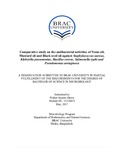| dc.contributor.advisor | Hossain, Dr. Mahboob | |
| dc.contributor.author | Shova, Nishat Anzum | |
| dc.date.accessioned | 2017-11-13T08:50:51Z | |
| dc.date.available | 2017-11-13T08:50:51Z | |
| dc.date.copyright | 2017 | |
| dc.date.issued | 2017-05 | |
| dc.identifier.other | ID 13126013 | |
| dc.identifier.uri | http://hdl.handle.net/10361/8507 | |
| dc.description | This thesis report is submitted in partial fulfillment of the requirement for the degree of B.Sc in Microbiology, 2017. | en_US |
| dc.description | Cataloged from PDF version of thesis report. | |
| dc.description | Includes bibliographical references (page 56-60). | |
| dc.description.abstract | The study was aimed to determine the antimicrobial activity of commercially available Neem oil, Mustard oil and Black seed oil against some disease causing organism such as Staphylococcus aureus, Klebsiella pneumoniae , Bacillus cereus, Salmonella typhi and Pseudomonas aeruginosa. This study of antibacterial activity against selected pathogens was done by dilution method, agar disc diffusion method and agar well diffusion method. Pathogens were taken from BRAC University stock culture. All three essential oils tested showed antibacterial activity against Staphylococcus aureus, Klebsiella pneumonia and Bacillus cereus and Salmonella typhi. Black seed oil and Neem oil showed highest rate of antibacterial activity even at very low concentration. In case of all four pathogens, inhibition of growth caused by Neem oil was more than 99%. Black seed oil inhibited the growth of Staphylococcus aureus and Bacillus cereus by 100% and by 99.97% in case of Klebsiella pneumonia. Mustard oil exhibited antibacterial activity against the tested bacteria by dilution method but no zone of inhibition was found by agar disc diffusion or agar well diffusion method. Pseudomonas aeruginosa exhibited very low degree of sensitivity to Mustard oil and Black seed oil. However, Neem oil showed antibacterial activity against Pseudomonas aeruginosa by dilution method only. The results showed that all these oils can be a good source of antibacterial agents. The encouraging results also indicate that these oils should be exploited as natural antibiotic for the treatment of several infectious diseases caused by these pathogens, and could be useful in understanding the relations between traditional cures and current medicines. | en_US |
| dc.description.statementofresponsibility | Nishat Anzum Shova | |
| dc.format.extent | 66 pages | |
| dc.language.iso | en | en_US |
| dc.publisher | BRAC Univeristy | en_US |
| dc.rights | BRAC University thesis are protected by copyright. They may be viewed from this source for any purpose, but reproduction or distribution in any format is prohibited without written permission. | |
| dc.subject | Oil | en_US |
| dc.subject | Klebsiella pneumoniae | en_US |
| dc.subject | Pseudomonas aeruginosa | en_US |
| dc.title | Comparative study on the antibacterial activities of neem oil, mustard oil and black seed oil against staphylococcus aureus, klebsiella pneumoniae, bacillus cereus, salmonella typhi and pseudomonas aeruginosa | en_US |
| dc.type | Thesis | en_US |
| dc.contributor.department | Department of Mathematics and Natural Sciences, BRAC University | |
| dc.description.degree | B. Microbiology | |

